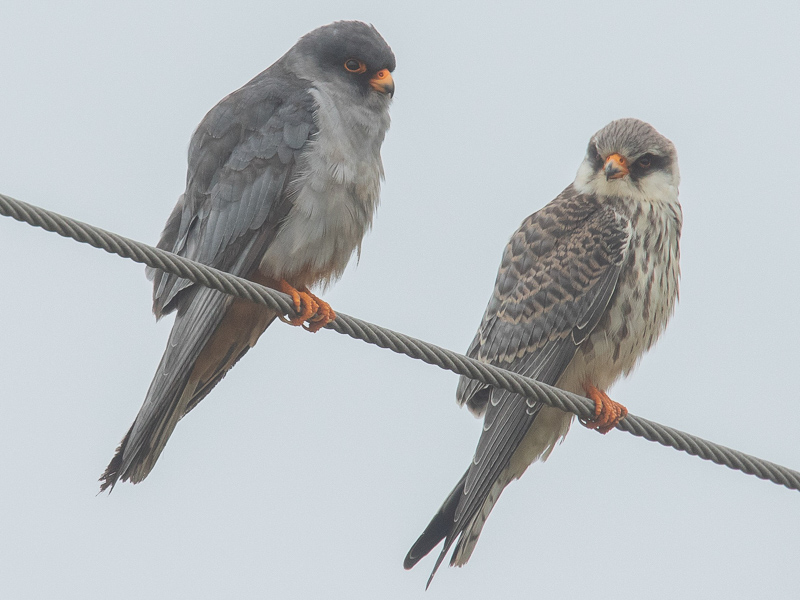Amur Falcon Falco amurensis 阿穆爾隼
Category I. Common passage migrant in autumn, rare in spring and winter. Seen over diverse habitats, most commonly open-country.
IDENTIFICATION

Oct. 2016, KWOK Tsz Ki. Adult male (left), juvenile (right).
28-30 cm. The adult male is very distinctive: dark slate-grey above, paler more bluish below with dark chestnut ‘trousers’ and lower belly and orange feet, cere and orbital ring.
The juvenile is paler than the adult female and has warm buff edges to the upperpart feathers, greyish streaks on the underparts and a finely-streaked crown.

Oct. 2021, Matthew Kwan. Adult female.
The adult female is duller and darker than the juvenile with grey bars on the upperparts and underparts and warm buff ‘trousers’.

Nov. 2016, Michelle and Peter Wong. Adult male.
In flight similar to Eurasian Hobby structurally but differs in slightly blunter wing tips and more broadly-based wings (at times recalling Peregrine Falcon). Adult males have highly distinctive pure white underwing coverts.

Oct. 2020, Kinni Ho. Juvenile.
From below, adult females and juveniles have whitish ground colour to underwing coverts with black barring and broad whitish bars at the base of the remiges; this pale area contrasts with the broad, dark trailing edge to the wings.
VOCALISATIONS
Rarely heard vocalising here. Utters a slightly grating ‘kyoo-kyoo-kyoo...’, a squealing, inflected ‘fyoooeee’ and a rapidly uttered series of notes that may vary in pitch across the phrase.
DISTRIBUTION AND HABITAT PREFERENCE
Often seen in migratory flight, Amur Falcon occurs in many parts of HK. The lowland areas of the northwest New Territories are favoured as open country dominates, but in part this could simply reflect observer activity.
OCCURRENCE
Amur Falcon is overwhelmingly a passage migrant in autumn, mainly from the second week of October to the second week of November (Figure 1). The earliest autumn date is 30 September 2018; passage peters out in late November, with the latest December record occurring on the 19th. There are three January records from 2nd and 17th, which is remarkable given the wintering area is in South Africa. Spring records are few and have occurred from 14 April to 20 May. Most records are of up to 15 birds, with the highest count being 100 on 10 October 2018.
After the the first record in 1999 (Leader 2007), Amur Falcon established itself as a common passage migrant in autumn in less than ten years. The reason for this is unclear. It is possible that the planting of trees to reduce desertification in north China has facilitated a population expansion that means birds now pass through HK regularly. Newer literature (e.g., Liu and Chen 2020) indicate the breeding range has expanded to include north China compared with older texts. Conservation measures in Nagaland, India stopped an estimated take of 120,000 to 140,000 individuals each year, but the effect of this only began in 2013 (BirdLife International 2022). This may, however, support the continued increase in numbers recorded here.
BEHAVIOUR, FORAGING & DIET
The only prey items recorded are dragonflies and bats. Early morning birds are generally seen passing straight through while evening birds are more likely to be perched on wires, fences or bare trees, or hunting prior to roosting.
RANGE & SYSTEMATICS
Monotypic. Breeds north and northeast China (as far south as Shandong) and adjacent parts of eastern Mongolia, southeast Siberia, Ussuriland and North Korea; passes through much of China and winters in South Africa (Orta et al. 2020, Liu and Chen 2020).
CONSERVATION STATUS
IUCN: Least Concern. Population trend stable.
Figure 1.

BirdLife International (2022) Species factsheet: Falco amurensis. Downloaded from http://www.birdlife.org on 21/04/2022.
Leader, P. J. (2007). Amur Falcon Falco amurensis at Mai Po Nature Reserve: the first Hong Kong record. Hong Kong Bird Report 2001-02: 174-177.
Liu, Y. and Y. H. Chen (eds) (2020). The CNG Field Guide to the Birds of China (in Chinese). Hunan Science and Technology Publication House, Changsha.
Orta, J., G. M. Kirwan, P. F. D. Boesman, and J. S. Marks (2020). Amur Falcon (Falco amurensis), version 1.0. In Birds of the World (J. del Hoyo, A. Elliott, J. Sargatal, D. A. Christie, and E. de Juana, Editors). Cornell Lab of Ornithology, Ithaca, NY, USA. https://doi.org/10.2173/bow.amufal1.01

